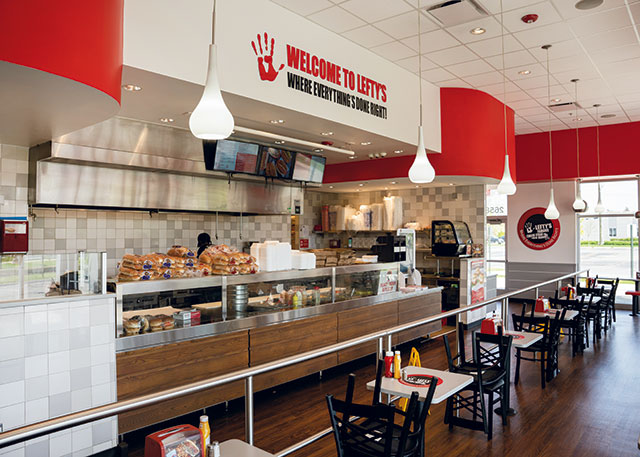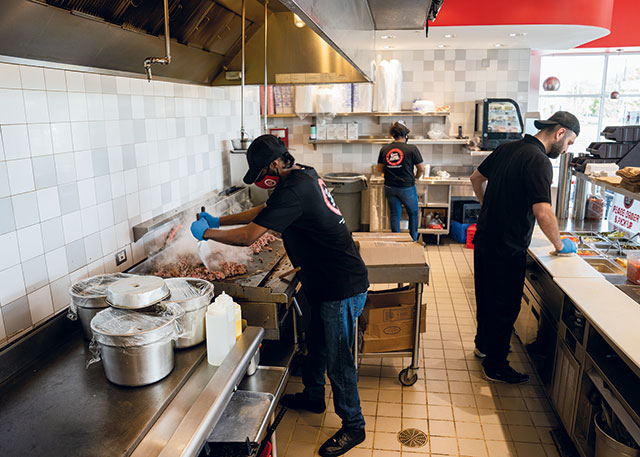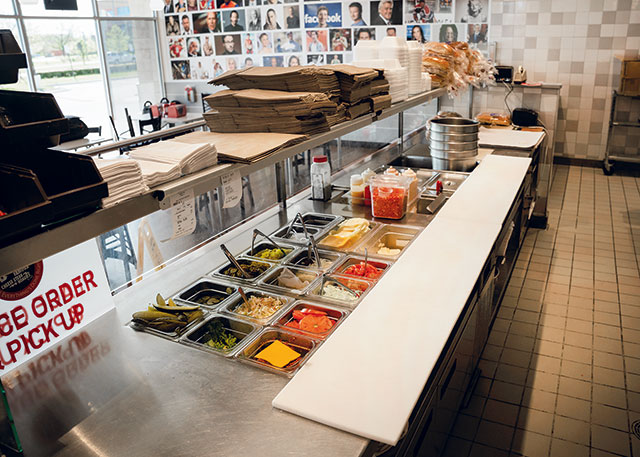This Michigan-based concept predicts national prominence in the wake of COVID-19.
Sam Berry has been in the foodservice industry for most of his life.
He started young, working at just 12 years old for his father and uncle at the family’s Big Boy franchise in Michigan. Later, he worked with his uncle, Allie Mallad, who owned, at different points, about 150 Little Caesars locations and 100 Bruegger’s Bagels stores.
By 2009, though, Berry was ready for a change. While he learned a lot working in franchised concepts, the experience left him wanting more control. “I didn’t want to be a franchisee of a company anymore. Nobody would ever listen to my ideas; nobody ever cared,” he says.
So he started his own concept, a fast-casual operation focused on high-quality sandwiches. Inspired by his own left-handedness, Berry dubbed his restaurant Lefty’s Famous Cheesesteaks, Hoagies & Grill.
 While the chain is currently focused on off-premises, its dining area can include booths or floating tables. Flooring is typically epoxy.
While the chain is currently focused on off-premises, its dining area can include booths or floating tables. Flooring is typically epoxy.
The first location opened its doors in Livonia, Mich., in 2010. Business was slow at the beginning. So slow, in fact, that Berry passed the time watching game shows on the restaurant’s television.
The concept eventually gained a foothold, though, and in the last few years began expanding. Today, Lefty’s boasts 16 locations in the Great Lakes State, 5 of which opened earlier this year. Led by Berry, the company’s president, and Mallad, now CEO, the concept has aspirations of becoming a national chain, with growth actually spurred by dining habits developed during the COVID-19 pandemic, they say.
According to Berry, the key to Lefty’s success is simple: It serves high-quality food in a niche without many players. While there are plenty of fast-casual operations that serve burgers, burritos and sandwiches, there just isn’t much competition for the cheesesteak dollar. “I noticed that not a lot of cheesesteak concepts are popping up,” he says. “It’s a good concept. It’s food for all ages. [Our customers] range from 14 years old to 70 years old.”
Small Menu, Simple Kitchen
Lefty’s isn’t relying on the lack of competition alone, though. The chain, says Berry, commits to freshness. Every morning, team members at each restaurant cook corned beef, grill steak and onions for cheesesteaks, slice deli meat and cheese, form burger patties by hand and hand roll its corned beef egg roll side dish.
This commitment to quality extends to Lefty’s menu, which remains small. While the chain offers around 20 different sandwiches (counting hoagies, burgers, cold sandwiches, etc.), Lefty’s uses just a handful of ingredients that staff mix and match to create these options. For example, at least three different sandwiches use corned beef, and five feature ribeye steak.
According to Berry, this approach has definite benefits. First, it makes for a more financially successful model. Instead of tying money up in lots of SKUs that rarely turn over, those funds can go toward the bottom line. Second, by offering relatively few menu items, Lefty’s is able to keep the quality of those offerings very high. Not only can employees focus on executing these items well, but the chain can also purchase and serve high-quality ingredients thanks to their fast turnover.
 Each morning, staffers cook around 100 pounds of steak on flattops.
Each morning, staffers cook around 100 pounds of steak on flattops.
“In order for you to have the freshest ingredients, the freshest products, they have to sell quickly,” Berry says. “If they are not selling quickly, they are just rotting on your shelf waiting for someone to order [them].”
This menu philosophy not only impacts SKUs and food quality, it also results in a small, efficient kitchen package.
Lefty’s assembly line sits in the front of the house, in full view of customers, with the hot line against the assembly area’s back wall and the cold line of sandwich toppings and ingredients 180 degrees away, in front of the customers.
Despite having its food on display, Lefty’s doesn’t have customers walk down the line, pointing to what they want on their sandwich. Instead, staff assemble sandwiches according to the menu. By putting its assembly line up front, though, the chain communicates the quality of its food.
 While the ingredients are on display, Lefty’s does not have guests walk down the line, picking what they want. Instead, sandwiches are made according to their menu descriptions.
While the ingredients are on display, Lefty’s does not have guests walk down the line, picking what they want. Instead, sandwiches are made according to their menu descriptions.
“I want all of our customers to see that we use the freshest ingredients. Nothing is hidden. It’s good; it’s live. People get to see and smell. You smell the onions; you smell the steak,” Berry says.
Lefty’s hot line sits under a 10- to 12-foot hood. The line includes two 70-pound fryers, which cook french fries, fried mushrooms, cheese sticks and egg rolls. The fryers pair with a fry dump station, where finished items can be held warm.
Next to the fryers, Lefty’s uses two flattop grills, each measuring four feet long. Staff use these to cook Lefty’s proteins each morning, including its steak, which is grilled and caramelized along with onions.
Last on the hot line are two large burners. After marinating corned beef in-house, staff use these burners to boil it on a daily basis.
The straightforward front of the line consists of sandwich tables holding roughly 15 toppings and ingredients in wells, with backup ingredients stored in refrigeration below.
Lefty’s back of the house includes a walk-in refrigerator, walk-in freezer and worktables. This space also includes various equipment for food prep, including food processing units and a deli slicer.
At a typical store, prep starts each day with four employees at 9 a.m. Notably, team members don’t prep for that day’s business, though. They’re actually preparing for the following day. This ensures the chain never runs out of ingredients.
“Once you run low, then the efficiency drops,” says Berry. “You don’t set yourself up for success; you set yourself up for failure. What if somebody came in and wanted a catering order with 40 egg rolls? You’re screwed [without enough prepped ingredients]. We’re always a day ahead. If you’re not a day ahead, you’re a day behind. There’s no in-between.”
Dine In, Dine Out
Matching its straightforward kitchen is Lefty’s straightforward dining room.
The chain’s signature colors are red, white and black. Lefty’s locations typically feature epoxy flooring and booths with an image of the Lefty’s logo in the tabletop.
The chain also has a few playful elements celebrating left-handedness. These include a mural wall with pictures of famous lefties, such as Mark Zuckerberg, Barack Obama, Oprah Winfrey and Bill Gates, though this feature may disappear in future stores, Berry says. Guests can also put themselves to the test by trying to write their name left-handed on a dry-erase board in Lefty’s Corner.
Notably, the dining room size isn’t going to change in the face of COVID-19, says Mallad. Lefty’s already operates in a small footprint, with stores as small as 1,200 square feet and a target size of 2,000 square feet.
Besides that, there’s little reason to change based on Lefty’s performance during the pandemic. According to Mallad, Lefty’s business has boomed in the face of COVID-19, with sales at its stores up 50% or more.
A big chunk of this growth comes in the dinner daypart, which is now bigger than Lefty’s lunch sales, Berry says. Post-pandemic, he expects to hold on to higher dinner sales while recovering lunch sales lost in lockdown. “I know it’s unfortunate for a lot of these big businesses, but I guarantee you they’re going to be forced to cut their dining rooms in half,” he says. “People are not going to want to eat out of silverware, plates, cups. It’s real bad for these big restaurants.”
In addition, the chain’s sales performance combined with the inherent appeal of the restaurant industry should help it draw plenty of attention from potential franchise partners, states Mallad. In fact, he expects a “gold rush” on the brand over the next several months.
Notably, Berry and Mallad count themselves among these franchisees. While Lefty’s has no corporate stores, it does have affiliate locations —
franchises owned by corporate officers, including its two leaders.
As the chain enters this expansion phase — while licensing was the chain’s previous model, it only began franchising in April — Lefty’s is looking to move out of Michigan, with a particular focus on California, Florida and Texas, which will quickly establish Lefty’s as a national chain, Mallad says.
From there, the sky’s the limit. The concept, its leaders say, can work in practically any market, so long as there’s enough traffic and a decent population density near the restaurant.
The lockdown should also help the chain find good real estate, Berry and Mallad add. While restaurant closures are unfortunate, they say, Lefty’s will be able to take over good spots previously occupied by other concepts.
“Jersey Mike’s has cheesesteaks. They are a 1,500-store chain,” Mallad says. “We know that once we go next to them, we are going to be the cheesesteak of choice. There’s nothing to figure out as far as where we need to go.”
Lefty’s is similarly open to a wide range of franchise partners, from one-store owner operators to large multiunit, multiconcept franchisees. It is even open to signing large area development agreements.
With this approach, the chain expects to grow rapidly over the next few years. After opening 5 new stores early in 2020, it now expects to reach 35 locations by the end of this year. Lefty’s leaders then expect it to hit 75 locations by the end of 2021 and 150 by the end of 2022.
This level of growth, Mallad says, will make Lefty’s more than a success. It will make it a standard-bearer for the restaurant industry going forward.
“We are going to be the face of the new norm,” says Mallad. “COVID-19 has helped us increase the possibility of attracting franchisees from all over the country because of our incredible sales as a pickup fast-casual concept.”
Lefty's at a Glance
- Key players: Sam Berry, founder and president; Allie Mallad, CEO; Carlos Guzman, chief operating officer
- Chain headquarters: Detroit
- Year founded: 2009
- Signature menu items: Cheesesteak, corned beef sandwiches
- Number of units: 16
- Unit size: Target size of 2,000 square feet; as small as 1,200 square feet




